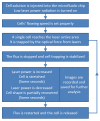A Comprehensive Review of Optical Stretcher for Cell Mechanical Characterization at Single-Cell Level
- PMID: 30404265
- PMCID: PMC6189960
- DOI: 10.3390/mi7050090
A Comprehensive Review of Optical Stretcher for Cell Mechanical Characterization at Single-Cell Level
Abstract
This paper presents a comprehensive review of the development of the optical stretcher, a powerful optofluidic device for single cell mechanical study by using optical force induced cell stretching. The different techniques and the different materials for the fabrication of the optical stretcher are first summarized. A short description of the optical-stretching mechanism is then given, highlighting the optical force calculation and the cell optical deformability characterization. Subsequently, the implementations of the optical stretcher in various cell-mechanics studies are shown on different types of cells. Afterwards, two new advancements on optical stretcher applications are also introduced: the active cell sorting based on cell mechanical characterization and the temperature effect on cell stretching measurement from laser-induced heating. Two examples of new functionalities developed with the optical stretcher are also included. Finally, the current major limitation and the future development possibilities are discussed.
Keywords: mechanical properties characterization; microfluidics; optical stretcher; optofluidics; single-cell analysis.
Conflict of interest statement
The authors declare no conflict of interest.
Figures

























Similar articles
-
An optofluidic "tweeze-and-drag" cell stretcher in a microfluidic channel.Lab Chip. 2020 Feb 7;20(3):601-613. doi: 10.1039/c9lc01026b. Epub 2020 Jan 7. Lab Chip. 2020. PMID: 31909404
-
High-throughput linear optical stretcher for mechanical characterization of blood cells.Cytometry A. 2016 Apr;89(4):391-7. doi: 10.1002/cyto.a.22794. Epub 2015 Nov 13. Cytometry A. 2016. PMID: 26565892 Free PMC article.
-
The Role of the Optical Stretcher Is Crucial in the Investigation of Cell Mechanics Regulating Cell Adhesion and Motility.Front Cell Dev Biol. 2019 Sep 4;7:184. doi: 10.3389/fcell.2019.00184. eCollection 2019. Front Cell Dev Biol. 2019. PMID: 31552247 Free PMC article. Review.
-
Deformation of phospholipid vesicles in an optical stretcher.Soft Matter. 2015 Aug 14;11(30):6075-88. doi: 10.1039/c5sm00562k. Epub 2015 Jul 2. Soft Matter. 2015. PMID: 26135540
-
Fiber Optofluidic Technology Based on Optical Force and Photothermal Effects.Micromachines (Basel). 2019 Jul 26;10(8):499. doi: 10.3390/mi10080499. Micromachines (Basel). 2019. PMID: 31357458 Free PMC article. Review.
Cited by
-
Narrow-Gap Rheometry: A Novel Method for Measuring Cell Mechanics.Cells. 2022 Jun 23;11(13):2010. doi: 10.3390/cells11132010. Cells. 2022. PMID: 35805094 Free PMC article. Review.
-
On-chip integrated optical stretching and electrorotation enabling single-cell biophysical analysis.Microsyst Nanoeng. 2020 Jun 15;6:57. doi: 10.1038/s41378-020-0162-2. eCollection 2020. Microsyst Nanoeng. 2020. PMID: 34567668 Free PMC article.
-
In Vitro Measurements of Cellular Forces and their Importance in the Lung-From the Sub- to the Multicellular Scale.Life (Basel). 2021 Jul 14;11(7):691. doi: 10.3390/life11070691. Life (Basel). 2021. PMID: 34357063 Free PMC article. Review.
-
Rapid computational cell-rotation around arbitrary axes in 3D with multi-core fiber.Biomed Opt Express. 2021 May 17;12(6):3423-3437. doi: 10.1364/BOE.423035. eCollection 2021 Jun 1. Biomed Opt Express. 2021. PMID: 34221669 Free PMC article.
-
Probing force in living cells with optical tweezers: from single-molecule mechanics to cell mechanotransduction.Biophys Rev. 2019 Oct;11(5):765-782. doi: 10.1007/s12551-019-00599-y. Epub 2019 Oct 14. Biophys Rev. 2019. PMID: 31612379 Free PMC article. Review.
References
Publication types
LinkOut - more resources
Full Text Sources
Other Literature Sources

